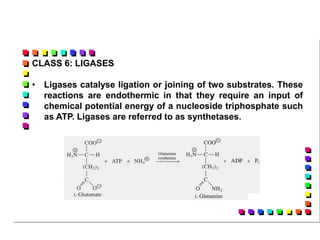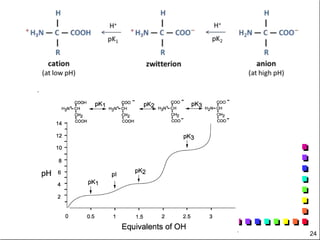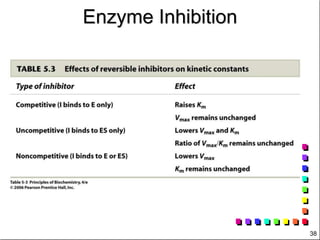Lecture 1 - Enzymes-Intro. Kinetics.PPT
- 1. 1 BIOC708 ADVANCED BIOCHEMICAL CORE TOPICS MODULE AIM: Introduce students to advanced application of gene products in biotechnology Lecturer and Module coordinator– Dr Karen Pillay ASSESSMENT: Test and Assignments (25%) Exam (75%) ???
- 2. 2 BIOC708 Application of enzymes in Medicine and Industry 1. What are enzymes? 2. Fundamentals of enzyme kinetics i. Enzyme nomenclature ii. Mechanism of enzyme action iii. Effect of pH and temperature on enzyme activity iv. Determination of Vmax and Km v. Enzyme inhibition 3. Sources of enzymes 4. Industrial use of enzymes 5. Preparation and Purification of enzymes 6. Immobilization of enzymes 7. Analyses of scientific publications
- 3. 3 Enzymes The Nature of Enzymes The Enzyme-Substrate Complex Regulation of Enzymes Enzymes in Medicine
- 4. 4 What Enzymes Are IS What They Do Biological catalysts - contain very large proteins • Are highly efficient catalysts Permit reactions to ‘go’ at conditions that the body can tolerate. Each enzyme molecule can process thousands or even millions of reactant molecules every minute (turnover rate). • Are very specific - catalyze the reaction of one or only a few types of molecules (substrates). • Regulate which cellular reactions take place (out of thousands of possible reactions that might otherwise occur in the cell) • How does regulation occur?
- 5. 5 Some Properties of Enzymes Specificity - The limitation of enzyme action to just one substrate or one type of bond. Turnover rate - How many molecules can be helped to react by each molecule of enzyme per second. Action low except at pH and temperature in vivo.
- 6. 6 A + B [A------B] C Reactants Transition State Product The transition state theory indicates that products are only formed after the reactant species has; a) Collided in an optimum spatial orientation that will progress to a chemical reaction between them. b) Acquired sufficient energy to reach a transition state wherein the bond breaking or bond forming chemistry is at some stage of development.
- 7. Figure 1: A catalyst reduces the free energy of activation ∆G‡ and not the standard free energy ∆G° of the reaction. The action of a biological catalyst enhances the rate of a chemical reaction because they decrease the free energy of activation (∆G‡) required for the reaction. That is a catalyst provides an alternative reaction pathway that requires less energy. Therefore the transition state can be attained with greater efficiency and frequency.
- 8. 8 Enzyme Nomenclature Naming is pretty easy compared to other compounds. Name is based on: - what it reacts with - how it reacts - add -ase ending Examples lactase - enzyme that reacts with lactose. pyruvate decarboxylase - removes carboxyl from pyruvate.
- 9. Six Major Classes of enzymes CLASS 1: OXIDOREDUCTASES • Oxidoreductases catalyze oxidation reduction reactions. • Most of these enzymes are referred to as dehydrogenases, but some are called oxidases, peroxidases, oxygenases or reductases
- 10. CLASS 2: TRANSFERASES • Transferases catalyze group-transfer reactions and many of them require the presence of a coenzyme. In these reactions, a portion of the substrate molecule usually binds covalently to the enzyme or coenzyme. This group includes the kinases.
- 11. CLASS 3: HYDROLASES • Hydrolyases catalyze hydrolytic reactions. They are a special class of transferases, with water serving as the acceptor of the group transferred.
- 12. CLASS 4: LYASES • Lyases catalyze nonhydrolytic and nonoxidative elimination reactions, or lysis of substrate reactions, generating a double bond. In the reverse reaction, lyases catalyze the addition of one substrate to a double bond of a second substrate. A lyase that catalyses an addition reaction in cells is often termed a synthase.
- 13. CLASS 5: ISOMERASES • Isomerases catalyse intramolecular rearrangement reactions, i.e. isomerization reactions. They are among the simplest of reactions due to the fact there is only one substrate and a single product.
- 14. CLASS 6: LIGASES • Ligases catalyse ligation or joining of two substrates. These reactions are endothermic in that they require an input of chemical potential energy of a nucleoside triphosphate such as ATP. Ligases are referred to as synthetases.
- 15. 15 Binding Model Enzyme molecules usually have two components: a polypeptide portion, called an apoenzyme, and a nonpolypeptide portion, called a cofactor. If the cofactor is organic, it is called a coenzyme. The active site is on the apoenzyme. In (a), the enzyme and substrate form a complex. In (b), the reaction oc- curs. In (c), the products separate from the enzyme.
- 16. 16 The Active Site Enzymes are typically HUGE proteins, yet only a small part is actually involved in a reaction. The active site has two basic components. catalytic site binding site Model of triose-p-isomerase
- 17. 17 Characteristics of Enzyme Active Sites Catalytic site - this is where the reaction actually occurs. Binding site - this is the area that holds the substrate in proper place. Enzymes uses weak, non-covalent interactions to hold the substrate in place based on R groups of amino acids. Shape is complementary to the substrate and determines the specificity of the enzyme (“lock and key” or “induced fit” models). Sites are pockets or clefts on the enzyme surface.
- 18. 18 Introducing E and S, the Players in an Enzymatic Reaction Catalytic site Binding site Substrate (S) Enzyme (E)
- 19. 19 Step 1 in Enzyme-catalyzed Reaction The first step is combination of E and S to form the enzyme-substrate complex . E + S ES . Enzyme Substrate Complex +
- 20. 20 Step 2 In the second step the complex goes through a transition state. An intermediate species is then formed. . ES ES* note change
- 21. 21 Step 3 The reaction changes ES* to EP. The activated enzyme-substrate complex then becomes an enzyme-product complex. . ES* EP
- 22. 22 Step 4 The enzyme and product separate. Now the product is finally made and the enzyme is ready for another substrate. . EP E + P
- 23. Effect of pH on Enzymatic Activity • The pH activity profile of any enzyme is dependant on the acid- base behaviour of the enzyme and the substrate, • i.e. any ionizable R-group belonging to the active site (catalytic AA residue); • ionizable R-groups of the structural AA residues and • ionizable groups belonging to the substrate molecule that is involved in binding interactions with the enzyme. • It is notable that the optimal pH of an enzyme is not necessarily the pH of the cellular environment. Thus it may be that the intracellular pH may exert some control on the activity of an enzyme.
- 24. 24
- 25. Effect of pH on Enzymatic Activity • Most enzymes have an optimal pH at which their activity is maximal. • If an enzyme is kept saturated with substrate at all pH values tested, many enzymes would have a pH activity profile that is characterized by a "bell-shaped" curve. • However the pH activity profiles of certain enzymes may vary considerably.
- 26. Effect of Temperature on Enzymatic Activity • The rates of enzyme catalysed reactions generally increase with temperature, within the T range in which the enzyme is stable and retains full activity. • Although enzyme catalyzed reactions have an optimum temperature, the peak in such a plot of catalytic activity versus temperature results because enzymes being proteins are denatured by heat and become inactive. • Most enzymes are denatured or inactivated at temperatures above 55C to 60C.
- 27. KINETIC CONSTANTS INVOLVED IN ENZYME ACTIVITY AND CATALYTIC PROFICIENCY
- 28. KINETIC CONSTANTS INVOLVED IN ENZYME ACTIVITY AND CATALYTIC PROFICIENCY Figure 2 Meanings of kcat and kcat/Km. The catalytic constant (kcat) is the rate constant for conversion of the ES complex to E + P. It is measured most easily when the enzyme is saturated with substrate (region A on the Michaelis–Menten curve shown). The ratio kcat/Km is the rate constant for the conversion of E + S to E + P at very low concentrations of substrate (region B). The reactions measured by these rate constants are summarized below the graph.
- 29. MEASUREMENT OF Km and Vmax Figure 3 Double-reciprocal (Lineweaver-Burk) plot. This plot is derived from a linear transformation of the Michaelis-Menten equation. Values of 1/ v0 are plotted as a function of 1/[S] values.
- 30. 30 Regulation of Enzymes Enzymes can be switched on and off by initiators, effectors, inhibitors, genes, poisons, hormones, and neurotransmitters. In the cases above, one active site is being acti- vated by an event occurring elsewhere on the enzyme, an allosteric effect.
- 31. 31 Enzyme Inhibition Allosteric effects can be inhibiting as well as activating, as in (a) above. (b) illustrates so-called competitive inhibition, in which a non-substrate molecule with a shape similar to that of the true substrate can compete with the substrate for attachment to the active site.
- 32. Competitive inhibition •A competitive inhibitor (I) is a substance that reversibly binds with the free form of an enzyme (E) to produce a binary EI complex that is incapable of binding substrate (S). •Therefore when E, S, and I are present, E can bind with S to yield ES, or E can bind with I to yield EI. However E cannot bind I and S simultaneously to yield a ternary EIS complex i.e.
- 33. Figure 4 Competitive inhibition. (a) Kinetic scheme illustrating the binding of I to E. Note that this is an expansion of Equation 5.11 that includes formation of the EI complex. (b) Double-reciprocal plot. In competitive inhibition, Vmax remains unchanged and Km increases. The black line labeled “Control” is the result in the absence of inhibitor. The red lines are the results in the presence of inhibitor, with the arrow showing the direction of increasing [I].
- 34. Non-competitive inhibition •This form of inhibition occurs when an inhibitor molecule or ion can bind to a second site on an enzyme surface (not the active site) but an inhibitor site. •Noncompetitive inhibitors do not resemble the substrate. •Inhibitor binding results in distortion or modification of the enzyme’s conformation, which prevents product formation. •The EIS ternary complex may either be totally or partially inactive in terms of catalyzing the substrate to product reaction. •In pure noncompetitive inhibition, with total inactivation, inhibitor binding does not affect substrate binding.
- 35. Figure 5 Classic noncompetitive inhibition. (a) Kinetic scheme illustrating the binding of I to E or ES. (b) Double-reciprocal plot. Vmax decreases, but Km remains the same.
- 36. Uncompetitive Inhibition •The inhibitor binds exclusively to the ES complex. •Substrate binding results in a modification of the enzyme’s conformation, which promotes the binding of the inhibitor.
- 37. Figure 6 Uncompetitive inhibition. (a) Kinetic scheme illustrating the binding of I to ES. (b) Double-reciprocal plot. In uncompetitive inhibition, both Vmax and Km decrease (i.e., the absolute values of both 1/Vmax and 1/Km obtained from the y and x intercepts, respectively, increase). The ratio Km/ Vmax, the slope of the lines, remains unchanged.
- 39. 39 Reference Author(s) Title Year ISBN Publisher Moran LA, Horton RA, Scrimgeour G, Perry M & Rawn D Principles of Biochemistry, 5th edition 2011 978- 0321795793 Pearson





![6
A + B [A------B] C
Reactants Transition State Product
The transition state theory indicates that products are only formed
after the reactant species has;
a) Collided in an optimum spatial orientation that will progress to
a chemical reaction between them.
b) Acquired sufficient energy to reach a transition state wherein
the bond breaking or bond forming chemistry is at some stage
of development.](https://image.slidesharecdn.com/lecture1-enzymes-intro-230802171555-4ae61ab7/85/Lecture-1-Enzymes-Intro-Kinetics-PPT-6-320.jpg)






















![MEASUREMENT OF Km and Vmax
Figure 3
Double-reciprocal (Lineweaver-Burk) plot. This plot is derived from a linear transformation of the
Michaelis-Menten equation. Values of 1/ v0 are plotted as a function of 1/[S] values.](https://image.slidesharecdn.com/lecture1-enzymes-intro-230802171555-4ae61ab7/85/Lecture-1-Enzymes-Intro-Kinetics-PPT-29-320.jpg)



![Figure 4
Competitive inhibition. (a) Kinetic scheme illustrating the binding of I to E. Note
that this is an expansion of Equation 5.11 that includes formation of the EI
complex. (b) Double-reciprocal plot. In competitive inhibition, Vmax remains
unchanged and Km increases. The black line labeled “Control” is the result in
the absence of inhibitor. The red lines are the results in the presence of
inhibitor, with the arrow showing the direction of increasing [I].](https://image.slidesharecdn.com/lecture1-enzymes-intro-230802171555-4ae61ab7/85/Lecture-1-Enzymes-Intro-Kinetics-PPT-33-320.jpg)





